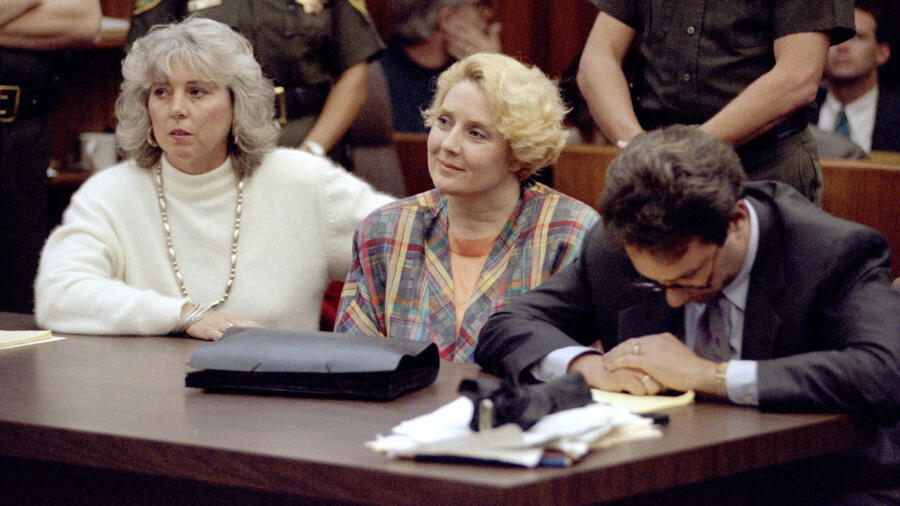Early in the morning on November 5, 1989, Elisabeth “Betty” Broderick drove to Marston Hills, near San Diego, and entered the home of her ex-husband, Daniel “Dan” Broderick III, and his new wife, Linda. Moments later, she crept into the couple’s bedroom and shot them to death while they slept.
At trial, prosecutors portrayed Broderick as a scorned woman who spiraled into a jealous, murderous rage. “I think she was angry,” testified Ruth Roth, a family therapist who tried to mediate the couple’s child-custody arrangement. Roth described Betty as uncooperative and claimed she didn’t exhibit any mental illnesses. Another psychologist testified that, while he didn’t believe Broderick had any mental illnesses, he did believe she had dual personality disorders: narcissistic (an inflated sense of self-importance) and histrionic (a pattern of excessive attention-seeking behaviors).
Defense attorneys argued that Betty was a battered wife driven over the edge by years of psychological abuse at the hands of Dan Broderick, a prominent medical malpractice attorney with money and influence. “Our position was that Dan drove Betty to the point of no return, and that’s where the evidence led,” Betty’s defense attorney, Jack Earley, tells A&E True Crime.
The high-profile case, which drew national media attention, divided the country. Three decades later, the debate continues over whether the ongoing psychological battles between Betty and Dan played a larger role in pushing the former socialite to commit murder.
Turmoil Beneath an Idyllic Facade
From the outside, Betty and Dan seemed to have a picture-perfect life. They met in 1965 when Betty, then 17, traveled to see a football game at the University of Notre Dame, where 21-year-old Dan was a senior in pre-med. The couple wed in April 1969. During their honeymoon, Betty asserts, Dan supposedly dismissed the help at their Caribbean villa, making clear his expectations that his bride should cook and clean for him. Betty returned from the getaway pregnant with their first child, who was born while they lived in his medical school dorm room at Cornell. As the Vietnam war claimed many young men his age, Dan continued his graduate studies, going on to attend Harvard Law School, while Betty supported their growing family by teaching, doing odd jobs and selling Avon and Tupperware.
In her 2015 memoir, Betty Broderick: Telling on Myself, Betty writes that after the wedding, Dan became extremely controlling. “He took charge of the bank books and my paychecks, and I more or less had to do what he said,” she testified at her trial. Soon after the couple’s third child died in infancy in 1973, Betty says she attempted suicide for the first time. “I felt totally trapped with [Dan] and cut off from my family. I just wanted to escape from it all and die. I was twenty-three and I couldn’t face decades more of this existence,” she wrote. She attempted, according to her memoir, to take her life at least one other time. The duo frequently fought, and Betty often threatened to leave. Dan, meanwhile, immersed himself in his studies and ignored her.
In May 1975, the family relocated from Massachusetts to La Jolla, California, where Dan began working as a medical malpractice attorney. He started his own law firm in 1978, earning almost $1 million a year and becoming a prominent figure in local legal circles. The Brodericks’ lavish lifestyle included new sports cars, first-class trips and constant entertaining. When Betty was not planning the next trip or dinner party with members of La Jolla’s social elite, she took care of their home and four children.
Already strained, the Brodericks’ relationship cracked in 1983, when Dan hired 21-year-old Linda Kolkena as his legal assistant. Betty, seeing clear signs of an affair (despite his denials), hit a breaking point on his birthday, when she learned the two had gone off together for the day. Betty went home, doused Dan’s clothes in gasoline and burned them in their backyard.
The couple separated, and Dan filed for divorce in 1985. Over the course of the lengthy, bitter proceedings, during which Dan executed complex legal and financial maneuverings to shield his assets, he moved into the family home. Linda soon joined him.
Frustrated that “he had possession of all our assets, and our children, and of our house and the furniture inside it,” Betty repeatedly vandalized the home and destroyed his belongings. She ignored restraining orders, reportedly made countless death threats and drove her car into the front of Dan’s house. Dan eventually gained full custody of their children and, using a legal loophole, sold the family home against Betty’s wishes.
Dan attempted to maintain control over Betty, docking her support payments when she acted out, sending her letters in curt legalese, and having her temporarily admitted to a mental health facility. Given his legal influence and standing in the community, Betty felt she had little recourse and described the court battles as “putting a housewife in the ring with Muhammad Ali.”
Suicidal or All for Show?
In court, Earley argued that although his client had fired the shots that killed her ex-husband and his new wife, she had entered the couple’s bedroom with the intent to only kill herself. “Before the homicide, there had been claims that she was suicidal for some period of time,” Earley says. “Our theory had been that Dan Broderick thought that she was going to kill herself.”
A week before the murders, Betty wrote a letter to her divorce attorney stating, “I can’t stand this anymore…them always insinuating I’m crazy.” Betty testified that when she went to Dan and Linda’s house on the morning of the murders, she intended to speak with him and then commit suicide because she “had no life left.”
Bradley Wright, Betty’s boyfriend before the killings and a prosecution witness, testified that she was suicidal. Earley described slash marks and scarring and had Betty hold out her left arm for jurors to see. Prosecutors refuted the testimony, claiming it was more for show and not evidence of actual suicide attempts. Mental health experts for the prosecution described how narcissism fueled Betty’s inflated self-importance and need to be the center of attention.
Their Mutual Psychological Manipulation Was Overlooked in Court
Experts say that Betty and Dan were caught in a destructive cycle of psychological manipulation. Individuals like Dan, who use deceptive and underhanded tactics “often do so to make an individual question himself or herself,” Tarra Bates-Duford, a forensic psychologist familiar with the Broderick case, tells A&E True Crime. Persons under attack (like Betty), she says, “will feel a loss of control, suspicious about the motives of others and struggle with increasing self-doubt.”
The defense accused Dan of gaslighting Betty—sowing seeds of doubt to make her question her memory, perception and sanity. “No one has the right to take the life of another human being, however, Dan’s consistent lies, minimizations and calling Betty crazy fueled a lot of the animus in the relationship,” says Bates-Duford. “Dan’s constant denials of an affair escalated Betty’s pre-existing [narcissistic] personality disorder and need for order.” With the loss of control, Betty felt she needed to go to extreme measures to regain that control. She would throw things at Dan, lock him out of the house, speak ill of him to other people and ultimately commit murder.
During the 1980s, not much was known about gaslighting and its significant impact on a victim’s behavior, says Bates-Duford: “When I read that a psychologist testified in the Broderick case that Betty was just ‘angry,’ I can’t help but think this statement was one of the most inept explanations for a double murder. To say Betty was simply ‘angry’ negates her previous extreme behaviors and outbursts.”
Psychologists for the defense also argued that Betty was depressed, explaining that her rage stemmed from her lack of any core identity—except what she took from Dan. “This is the family that Dan Broderick destroyed,” Earley told jurors moments after slamming a framed portrait of the seemingly picture-perfect family onto a podium and shattering it, to the shock of those in the courtroom.
Betty Broderick’s first trial ended in a hung jury. At a second trial, on December 11, 1991, a jury found her guilty of two counts of second-degree murder. She was sentenced to 32 years to life in prison. Although Earley describes Betty Broderick as a model prisoner with no write-ups, she has twice been denied parole, once in 2010 and again in 2017, for not showing remorse or a change in character. Her next eligibility is January 2032.
Related Features:
Stacey Castor and Other Women Who’ve Gone to Great Lengths to Kill Their Husbands
What Drives Some Women to Kill Their Kids?
What Really Happened to Belle Gunness, Serial Killer and Butcher of Men?


